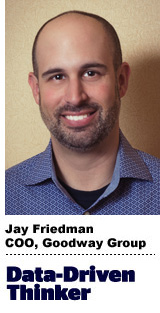 “Data-Driven Thinking” is written by members of the media community and contains fresh ideas on the digital revolution in media.
“Data-Driven Thinking” is written by members of the media community and contains fresh ideas on the digital revolution in media.
Today’s column is written by Jay Friedman, chief operating officer at Goodway Group.
In the early 2010s, a few assumptions seemed undeniable for media buyers.
They believed programmatic was growing rapidly with user-level targeting, for example, providing never-before-seen efficiency. They understood that buying this way was complicated, requiring a new kind of expertise at the agency and marketer level. And they saw the supply of inventory as unlimited, expecting prices to crash in a race to zero.
That last one turned out not to be true. Far from it. What we’re learning today on the buy side is that the real amount of good-quality supply is not only limited, but requires effort to get to. This has long been a criticism of programmatic from savvy publishers managing the fallout from increasingly lower yields, but their voices were dismissed by eager buyers who only cared about $1 inventory.
What caused that “unlimited” supply to become very limited during the last five years?
- Bots: By some accounts early on, it may have been 20%.
- Domain spoofing: Recently, FT.com pointed to $1.3 million of spoofed spend in a short period of time.
- Nonviewable ads: Even if we accept 70% viewability, we’re already down to less than 50% of the inventory we thought was available.
- Header bidding: Header bidding has increased the competition for good audiences on good publishers and increased prices.
Here’s the problem: I still regularly see RFPs requesting requiring “sub-$10 CPM full-episode player video,” among other craziness. Marketers, sometimes led by their agencies but sometimes not, were trained on the unlimited-supply story but, despite the obvious impact these four factors have on market dynamics, marketers are still instructing their agencies to treat media buying as a cost-cutting exercise.
Just so we’re clear, there is no sub-$10 full-episode player video. None. In fact, there’s little to no $10 true video – pre-roll, not in-banner. What is available is $25 to $75 CPM video.
Nearly every major publisher is simply sold out of video, and it’s all sold in this range. Not that it can’t be bought, but the bid will have to be more than what’s already sold in this range. The display story is not as drastic but follows a similar pattern. Digital media is no longer underpriced, but instead able to deliver measurable, ROI-positive results.
What now?
There are three simple things we can do to move toward good-quality inventory at a fair price.
First, we must reset pricing expectations and do ROI-based planning. As I once heard the CMO of a pet food brand say, “If I show one more ad to a person who doesn’t have pets, I’m going to scream.” Fifty-dollar CPM video is actually “cheap” if 100% of your ads are on-target compared to other media.
Second, marketers should reduce their number of suppliers. Through Ads.txt and supply-path optimization, also called combinatorial or dimensional bidding by some, we now know there is no need to buy from 70 different supply-side platforms. Or 40. Or even 20. As a result, cutting down the supply might mean having to eliminate as much as 50% of the bid stream in a platform.
Finally, marketers must educate their clients and bosses. Digital media is hyperdimensional. There are so many facets to the quality of an ad impressions that for every willing buyer of $10 CPM “video,” there is unfortunately a willing seller of this “video.” It’s usually in-banner or outright fraud. We wouldn’t believe someone selling 10-cent lottery tickets, so why do we believe prices in digital that are clearly too good to be true?
Spending $1 in digital doesn’t need to return any certain number of impressions. It needs to return more than $1 in EBITDA or net profit to an enterprise such that each $1 of media truly is an investment and not an expense. When we buy quality over price, we get real return over hype.
Follow Jay Friedman (@jaymfriedman) and AdExchanger (@adexchanger) on Twitter.
This post was syndicated from Ad Exchanger.

More Stories
Taste paradise with Whittaker’s new Mango & Coconut block
Temu’s Advertising Avalanche Is Impossible to Ignore
Publicis Media Exchange ANZ appoints Anthony Ellis as CEO